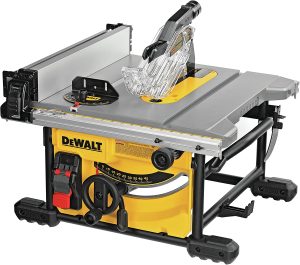Table of Contents
Introduction
If you work in construction or find yourself performing DIY task all the time, then you know how important it is to own the proper tools in order to get the best results. Most especially when you are working with wood, you will need tools that allow you to complete your job efficiently and quickly without making concessions on the quality of your work.
We all know that your work is a reflection of who you are and you will want people to appreciate the craftsmanship of your work, even though they might not fully understand what it took to achieve it. If you work with wood regularly, you will need a tool that will make your work easier, thereby letting you focus your energy on the art your workpiece will be. One of the best tools when it comes to woodworking is a table saw.
A table saw is an essential tool for every woodworker to own; whether you’re a professional or a hobbyist. They come in varying sizes and shapes and help you to accurately cut wood at your convenience. You will be able to make cuts in a shorter period than you would be able to with a hand saw and the accuracy will be spot on.
A table saw has a rotary sawblade standing at the centre of a flat worktable, it has fences and guides for safety. It is used in cutting solid wood or boards to smaller sizes.
Table saws provide you with a clean and precise cut, and this allows you to measure and fit your pieces together much later easily. By purchasing a table saw, you will be able to make crown moulding, cut boards and straighten crooked or curved boards.
Types Of Table Saw Blades
There are different types of table saw blades and having the appropriate blade for different cuts is important. Having the right blade can mean the difference between an accurate, smooth cut and a rough-edged cut that won’t fit properly. There are four main types of blade to choose from, they include;
Rip Blades
These type of blades possess large, chisel-like teeth that have deep spaces between them. The way their teeth are set makes them great for cutting in line with wood fibres. They also have large gullets for removing the large amount of sawdust that is produced during cutting.
Crosscut Blades
These blades have a much smaller and closely mounted tooth when compared to the rip blade, and they are made to cut across the wood’s grain without tearing it.
Related: What Is The Difference Between a Chop and Miter Saw?
Combination Blades
These blades are great for homeowners that own a woodshop because they are made to cut both with and across the wood grain. Their performance level is not as high as that of the crosscut blade or a specialized rip, but they are convenient because you don’t have to constantly change the blades every time you want to make a different cut and this makes them time friendly.
Carbide-Tipped Blades
This blade is the combination of the performance of specialized blades and the versatility of combination blades, and this makes them an interesting option for both home and professional use. However, they can be quite expensive.
Apart from these four main types of table saw blades, there are still five available blade types, and they commonly are known by their acronyms.
Uses Of A Table Saw
Table saws are used for quite a number of different tasks that include;
Ripping
This is the most common use of any table saw. It is used to cut large boards into smaller pieces that are easier to work with. Cutting wood or ripping to width is done parallel to the grain of the wood. Always run the board directly against the rip fence and never do it freehand, to avoid the risk of bending board and jamming the saw.
Crosscutting
Crosscutting is when the wood is cut to length. It is named crosscutting because the cut is made across the wood’s grain. This can be done accurately with a sliding crosscut table guide. If you need to make an angled or miter cut, then you have to make use of your table saws adjustable miter gauge. Adjust it to the needed angle and check again with an angle measure, then firmly hold your workpiece against the fence as you pass the wood through the blade.
There are a whole lot more than table saws can be used for, they include bevel cuts, cutting grooves and rabbets, cutting joints and kerfing.
Conclusion
Ensure that you take your time in finding the right information so that you get a model that can meet all your needs. With time you will learn to love and appreciate the work that your table saw can help you achieve.

